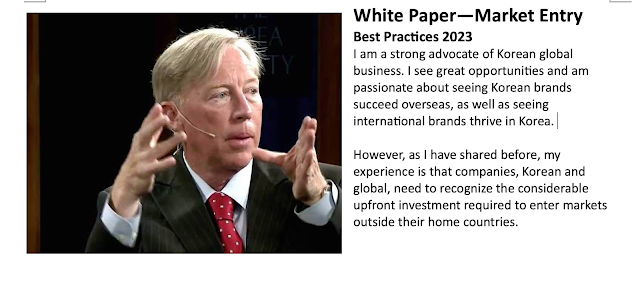I am a strong advocate of Korean global business. I see great opportunities and am passionate about seeing Korean brands succeed overseas, as well as seeing international brands thrive in Korea.
However, as I have shared before, my experience is that companies, Korean and global, need to recognize the considerable upfront investment required to enter markets outside their home countries.
In this White Paper, I would like to share what I see as best practices.
Step 1: Do your homework
Invest time and resources in the Discovery of the local market. Seek out an expert knowledgeable in both the local market and business sector to perform an objective, detailed competitive analysis. The report should identify the strengths and weaknesses of the competition within the market, strategies that will provide you with a distinct advantage, the barriers that may prevent you from entering your market, and weaknesses in the competition that can be exploited.
Too often, I see a company just scratch the surface in their market discovery. In some cases, this is to control initial investment costs by assigning in-house teams to work remotely by researching via a Google search.
In other cases, the staff at headquarters dispatches a team to do some “field work,” attend trade shows, and perhaps arrange to visit a few potential partners.
These fall short of a legitimate competitive analysis.
Step 2: Get in front of the right people
For highly recognized U.S. or global brands, there is less of a barrier in setting up meetings because the product or service name recognition does open doors. I have found that this recognition at least generates enough interest for a potential partner to want to learn more.
For Korean brands entering an overseas market, there is considerably more effort needed to establish upfront credibility.
I should point out that an up-front cost comes with arranging solid introductions. This process is very time-consuming for both international and Korean market entry. Additionally, anyone with the skill set, savvy, and reputation to make introductions, especially with decision-makers, cannot be expected to do so as a favor.
Step 3: Share your brand, product, and service like a first date
Although in the past, this was best done in person, I recognize introductions and first contact today is often “virtual.” That said, any content presented at this stage should be the very highest quality and well localized.
Far too often, I see re-purposed PDF and PPT presentations—not unique, custom-tailored content.
Then, make sure the grammar, spelling, and punctuation are double-checked by a native speaker, and the pages are free of format glitches.
At the very least, interested parties will Google a company, and often you personally, in advance of any meeting, so having a professional website is advised. Even better are postings by 3rd parties, such as PRs and media articles that showcase the company as a legitimate business.
Step 4: Share the Vision
During their screening and selection process, global companies will select a top candidate among potential partners based on a number of criteria—the foremost being the partner’s solid vision and business plan in the market. They will ask if the local partner has performed a detailed competitive analysis (see Step 1). They will then ask for a comprehensive Go To Market Business Plan. As a best practice, the Business Plan needs to be detailed, not a three or four-page company overview.
As with PDFs or PPTs shared in introductions, the Plan must be free of glitches, poor grammar, or spelling errors. The documents need to present an attractive, sound business opportunity.
BTW, a Company PDF that showcases your brand is great, but frankly, most potential parties are most interested in a solid business and go-to-market plan
All said, these four steps are best practices that can lead to a successful Letter of Understanding to clarify in writing terms that might have been discussed via email and/ or in conversation.
These steps require time, resources, and commitment—there are upfront costs, unlike past and current practices in Korea that traditionally required less investment or were absorbed by the company.
Experts, like BCW, with a proven track record, will not work on contingent, paid only when there is a signed deal and perhaps months later when there are transactions.
And in regard to local market legal support, navigating the cultural and legal nuances of contract negotiations and drafting, and regulatory frameworks, “A little money carefully spent at the front end of market analysis, and during initial negotiations will always save a lot more money later in the process.”—as a trusted legal colleague has noted.
Frankly, global business comes with challenges and risks. The effort requires embracing a new model and taking bold action by committing resources to a project that takes them into uncharted waters even when they feel a more practical approach is to tackle each stage as it unfolds.
I am open to discuss any questions.
And I’m also happy to steer you in the right direction.
Plus, our team can provide the support and resources needed for your market entry.
Dsoutherton@bridgingculture.com

No comments:
Post a Comment